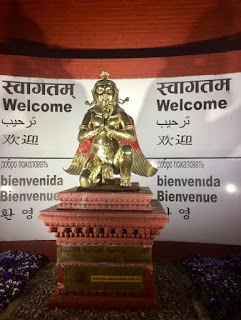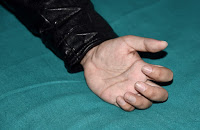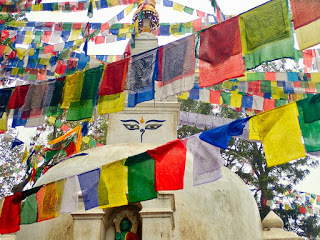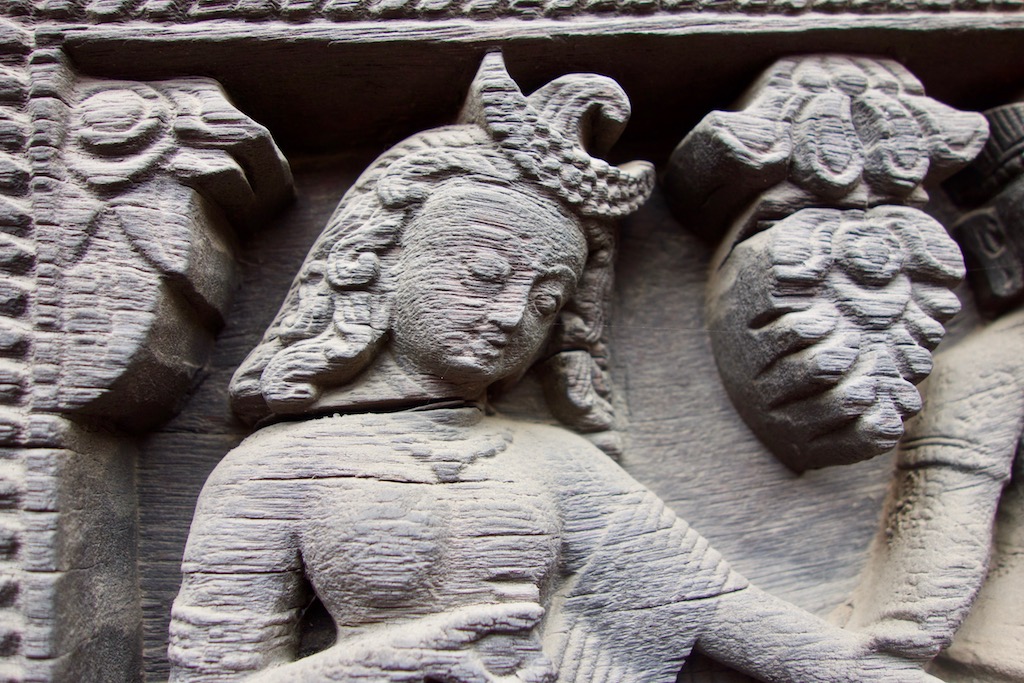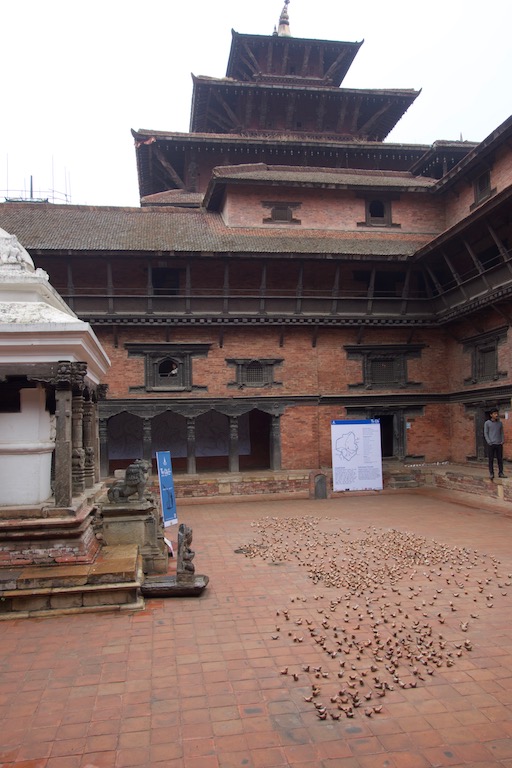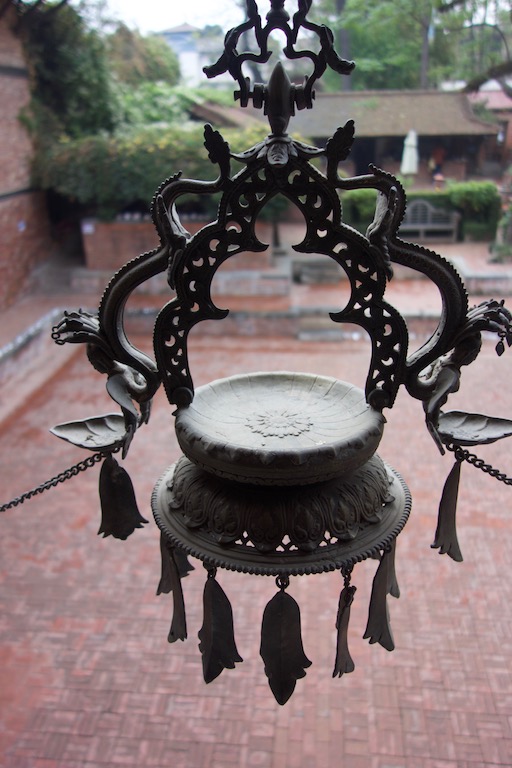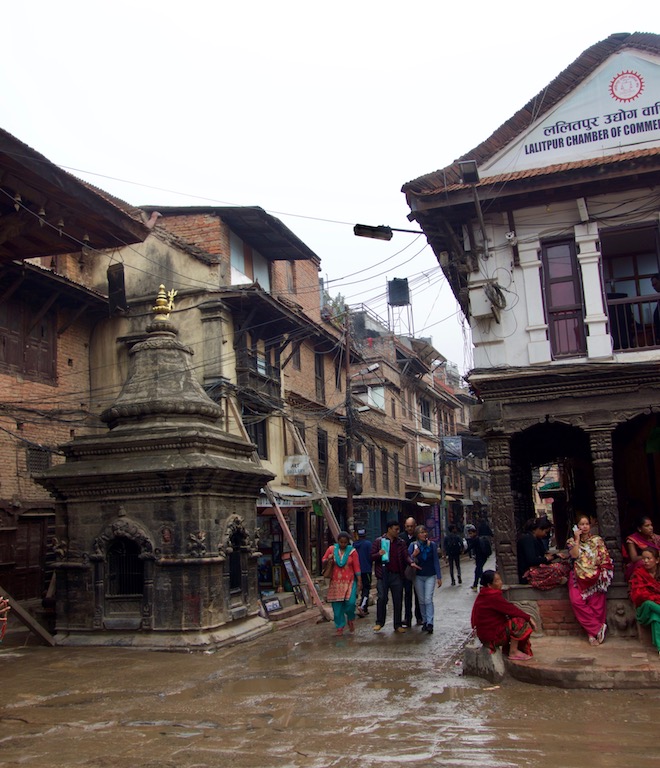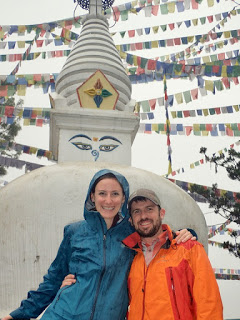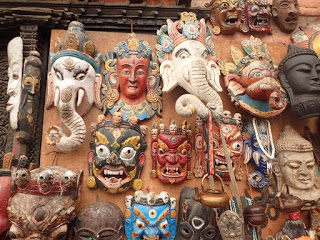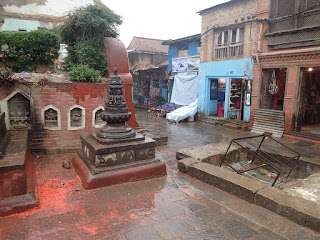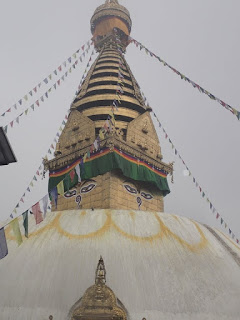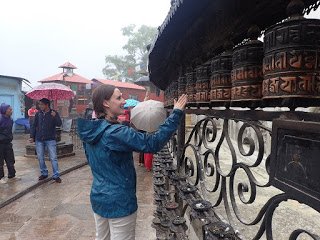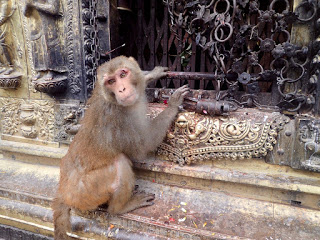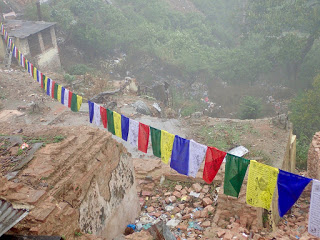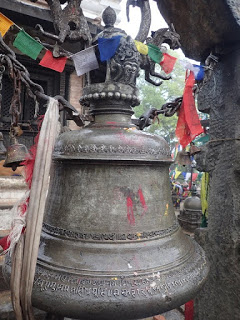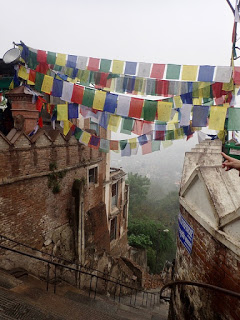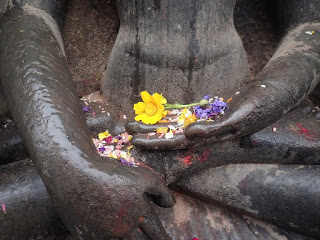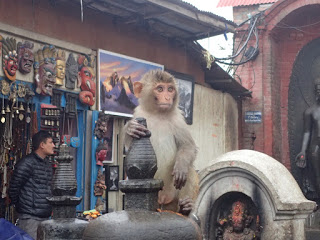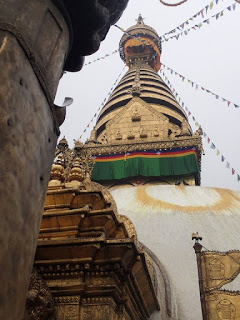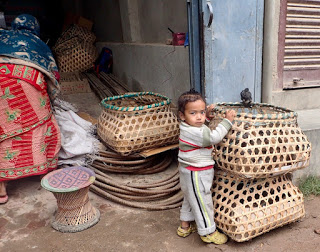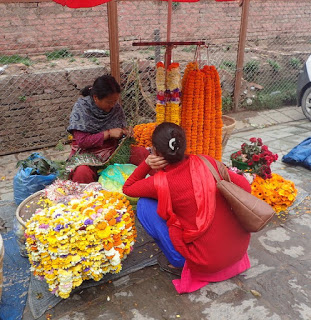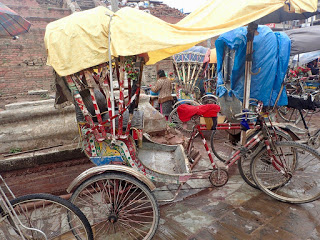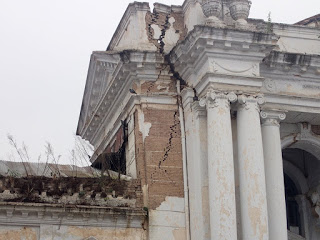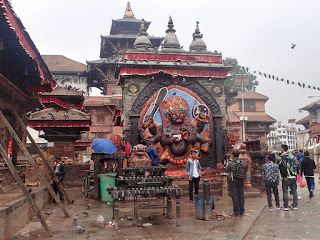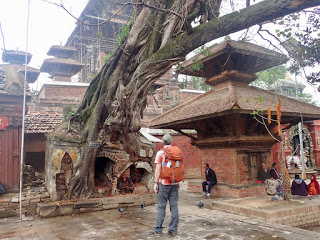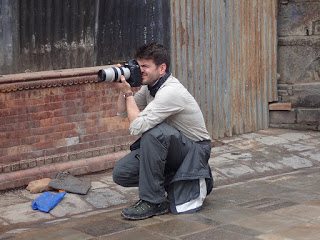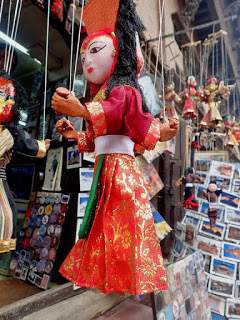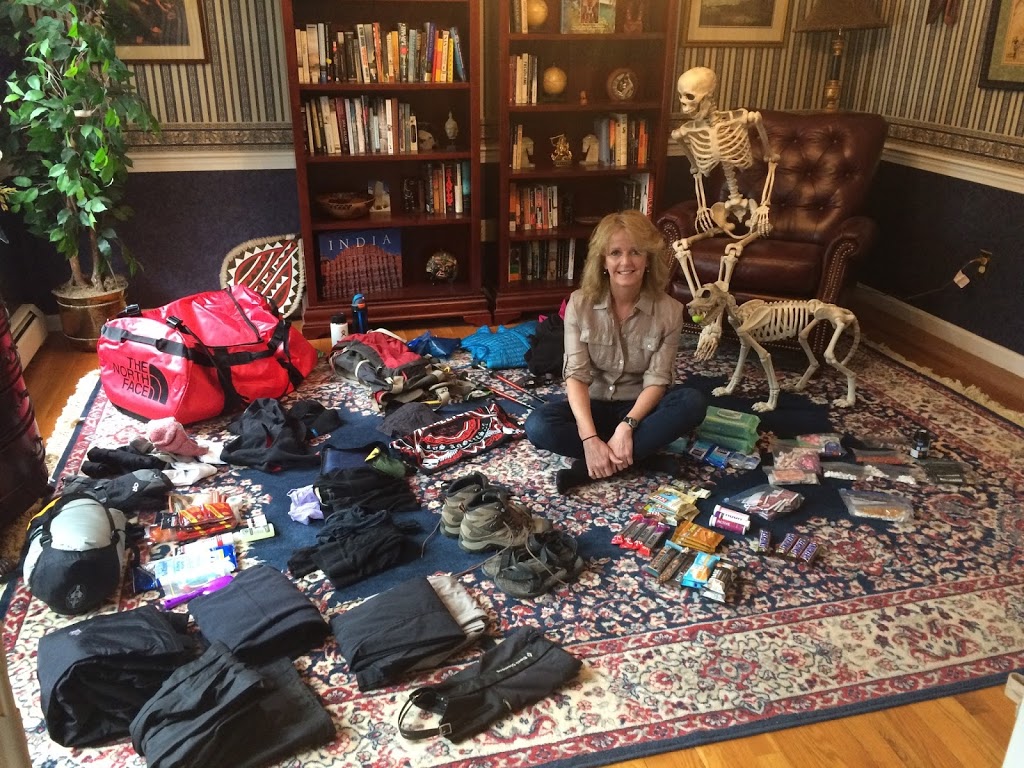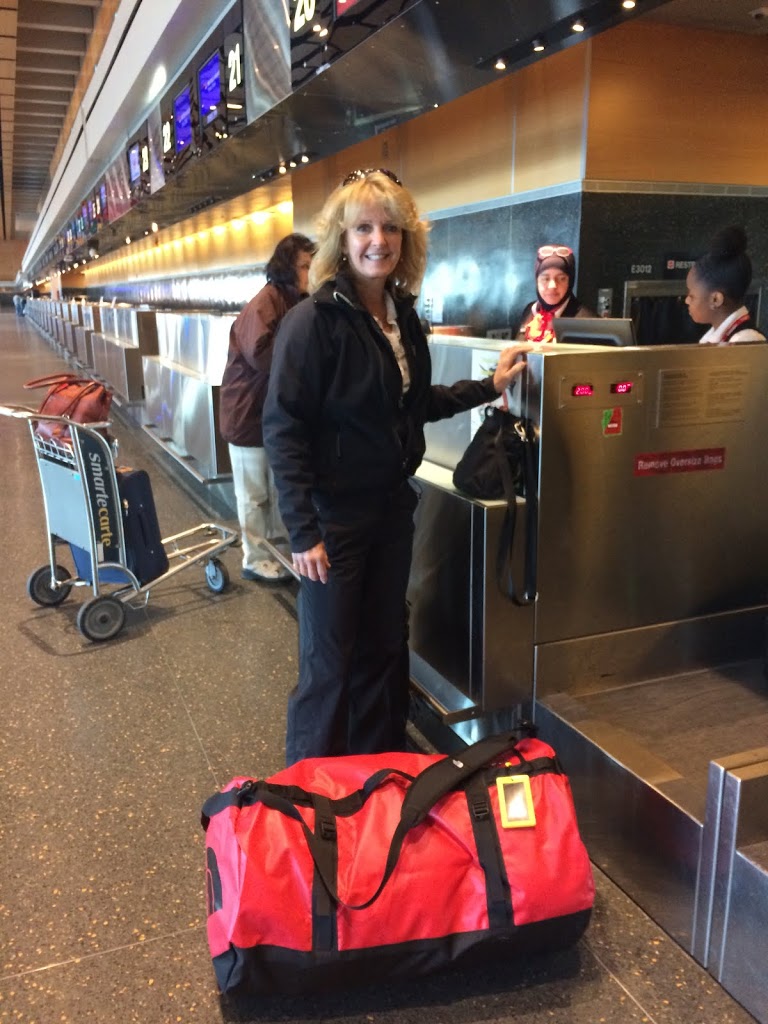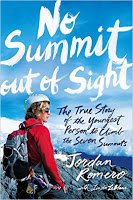Aim to Fly and Touch the Moon
Kathmandu, Nepal after 18 months, and still there are so many signs of the massive earthquake that rattled the country on April 25, 2015.
The
air quality remains poor: my throat feels raw and my eyes water. Our team wears filter
masks strapped to our faces, to protect our lungs. The city at night pulsates like a
living being: through the streets motorbikes, cars, rickshaws, trucks flow,
belching out waste, laced overhead by a gnarly grey network of telephone wires
and cables at each street corner.
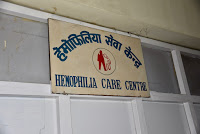 I’m here with the crew from Believe Ltd, who will be filming hemophilia B patient Chris Bombardier as he meets with the Save One Life program partner, the Nepal Hemophilia Society (NHS), and patients, and prepares for his Everest attempt. Chris’s wife Jessica accompanied him and will trek with us to base camp. She and I will stay two nights, then come back to Kathmandu while Chris stays another month, acclimating for the big climb. Should Chris summit, he will be the first person in history with hemophilia to conquer Everest. With
I’m here with the crew from Believe Ltd, who will be filming hemophilia B patient Chris Bombardier as he meets with the Save One Life program partner, the Nepal Hemophilia Society (NHS), and patients, and prepares for his Everest attempt. Chris’s wife Jessica accompanied him and will trek with us to base camp. She and I will stay two nights, then come back to Kathmandu while Chris stays another month, acclimating for the big climb. Should Chris summit, he will be the first person in history with hemophilia to conquer Everest. Withall the camera equipment, and Rob Bradford (photography), Jess, Chris and I in another, so Rob can
film. I enjoy their wide-eyed first look at Nepal with all its helter-skelter traffic
and humanity.
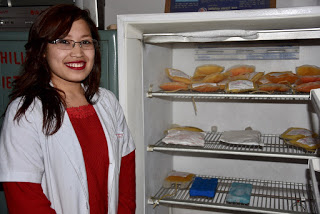 First stop today, Tuesday, March 28, is the Bir Hospital, where I’ve been three times
First stop today, Tuesday, March 28, is the Bir Hospital, where I’ve been three timespreviously. I first came to Nepal in 1999 for an assessment visit, then returned in 2000, when my company funded a medical conference. I was so impressed with the NHS then. And more so now. The NHS became our second program partner for Save One Life solely based on their ability to get the job done right, and fast. They are a crackerjack team and work hard to help their patients.
traveling with a film crew this time. I’m used to moving fast and ducking in and out. But
with about 200 pounds of camera and sound equipment, we have to move carefully
and cautiously. The hospital is still in disarray following the earthquake. It’s dark and uninviting. But the hemophilia treatment ward is brightly lit,
clean and orderly. No patients are there at first, and while the crew films,
we chat with the two lovely nurses.
A high number registered! About 200 make regular visits to the HTC, also a
high number. The center is now open 24 hours a day, which is excellent. They have a small
fridge, under lock and key, for factor. Inside is the Biogen/WFH donation of
Alprolix and Eloctate. This donation is absolutely revolutionizing care,
because it provides consistent product availability, which allows for planning, which leads to a
changed mindset. (I will write more about this in the August issue of PEN).
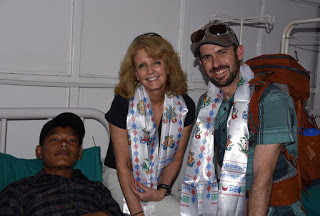 The nurses slipped silk scarves about our necks and greeted us with
The nurses slipped silk scarves about our necks and greeted us with“Namste!” as we each entered. The ward was upgraded! Freshly painted, with new
offices for factor storage and for the nurses’ office; it looks excellent. A freezer held
fresh-frozen plasma, something you never see in the US; this is for patients
with rarer factor deficiencies, or for when there is no factor.
Then a patient walked in: 18-year-old Bibek, a handsome, tall young man,
slender, with an apparent elbow bleed. Despite what must be searing pain, he
smiled broadly, was calm and accepting, gracious. It’s how the Nepalese are:
deeply ingrained in each seems to be a gentle approach to life, respect for
all, and profound civility. They have much to teach the world about how to get
along with others.
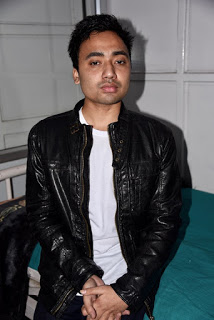 We chatted with him and learned he had to travel 3 hours to reach the
We chatted with him and learned he had to travel 3 hours to reach theHTC for one injection of 1,000 IU, not even enough for his lanky frame. And the
elbow bleed started the day before. He didn’t put ice on it because there is
none where he lives. Still he smiles; his face is placid and open, inviting.
His English is excellent.
hallway, then enter again, replay every conversation and act. We joke it’s
Bollywood and we should sing and dance our way in. Think the ending of Slumdog Millionaire! So we comply and redo the entire entry, greeting,
conversation. I ask them to include the photo of the mom who died in the
earthquake, while she was assisting in blood donations. She’s a true hero.
Ashrit. I regret that I didn’t recognize him at first. We chatted, and he
lifted his leather jacket sleeve to reveal a clawed hand: Volkman’s
contracture. Repeated bleeds for four years have left his left hand useless,
and in a permanent grasp. The saddest part is that he loves to play guitar. I
ask who his favorite guitar player is and he rattles off a long list: Jimmy
Page, Angus Young, Jimi Hendrix… “Slash?” I ask. Oh yes! He’s amazing! So we
share stories of guitar players and music, and he knows how to play Sweet Child
O’ Mine (one of my favorites). He even learned to play with one hand and had Jess and me listen to a
recording on his phone. It’s beautiful. He has talent. He also shows artwork, a
pencil sketch of a child, which is beautiful and haunting.
motorcycle? And I picked at his leather jacket. He started laughing, and I said
I know you Nepalese boys and your motorbikes! He said he used to but not any
longer. Such a sweetheart. He needs surgery. The
main problem? He has an inhibitor. Life has dealt this young man a double blow
but still he smiles and has dreams. I want to help him get surgery.
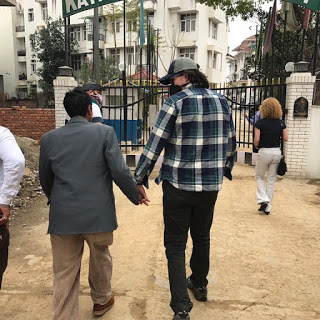 After
Afterthe Bir Hospital we drove to the Nepal Hemophilia Society office, in the
residential district. Some wiry teens were playing cricket in the street; birds
chirped, the sky was overcast and the air cool. Inside was crowded. They had
built out the office, including a new cold room, to store the donations from
Biogen; this means they could easily handle our proposed 4 million IU donation.
Manil Shrestha (also a patient) and his team are doing a great job. We asked questions, Believe Ltd. filmed… all good material for the documentary.
Mani suggests we go to “KFC,” which
we all think means Kentucky Fried Chicken. We scuffed across the dusty street,
to the main street, with cars, motorbikes and trucks bulleting past us. It’s
very dangerous to cross. Up the high curb (we have to help one another) and
into KFC: Kwik Food Café. I’ve eaten here before. The bathroom sported a squat
toilet, which is actually hard for patients with hemophilia to use–just think about it. Nepalese food is excellent and we down dumplings (called momo),
French fries, noodles, vegetables and Cokes. The talk is happy and light, and
everyone has a good time.
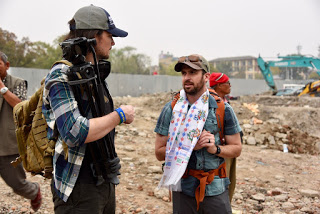 On the way back I witnessed a tender moment seeing Patrick
On the way back I witnessed a tender moment seeing Patrickchat with Beda Raj, a board member and also patient, and hold hands, which is the custom here among close male friends. Patrick is a rising star in our community: driven, ambitious, articulate, with a kind heart and compassionate soul. He
lost his 18-year-old brother Adam and it has impacted him greatly. Afterward,
we head for the Shanker hotel, and have dinner together at 7 pm. Everyone has Everest
beer and I have wine, and we share stories from the day.
March 29, 2017
It was rainy, which was disappointing, but then the air was remarkably cleaner
and easier to inhale. We start our day in the dining room together, and I enjoy
a breakfast of eggs, croissants, muselix (delicious), fresh watermelon and
mango, and steamy masala tea. Everyone is obsessed with their photos and we compare them.
Then off to Swayambhu, the “Monkey Temple,” close
by. We draw a crowd because of all the camera equipment. The focus is entirely on Chris; making a pilgrimage to this most famous of temples, in preparation for his climb. I feel very much at peace in Swayambhu. The colorful prayer flags
dance in the wind around the stupas with the painted eyes of Buddha watching. Stray
dogs, their tails eternally curly, strut about in the rain or sleep at the base
of the stupas or even inside the arch of the little temples to escape the rain. Bold macaque monkeys leap and swing overhead, fighting with one another, scanning
for food. They are a rough lot; some are missing patches of fur, and one is
actually missing a nose. One baby has a mangled leg he drags about. Birds chirp
and somewhere a cuckoo chimes.
level, where the gift shops are. The rain is pelting but I have an umbrella and
water-proof camera. I’ve been here twice before and so just enjoy it all. Other
trekkers are here, maybe German. I’m intrigued as always by the Hindu masks on
display. Jess and I meet up and I film her spinning the prayer wheels.
wouldn’t be? He didn’t set out to make a documentary, only to climb the Seven Summits
for a cause–Save One Life. Shy by nature, he comes across as
authentic, humble, and people will be drawn to that. So soft-spoken but a core of steel!
at the temple, and candles at another temple. A monkey bolts up, grabs an
offering of food meant for the gods, and scoots away. They are fast and mischievous. There’s still
earthquake damage, manifested in cracks in the buildings and piles of bricks which is so sad at this ancient of sites. The rain came and went, as we walked about. It took a while to get the tickets, and we stood on a street corner watching all the people walking by. Women with lined faces and colorful but damp saris tried hard to sell us trinkets: bracelets, necklaces, purses. “Good price I give you,” “Madame for you?”
Off to Nepal.. and Everest
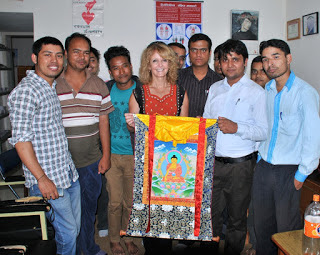 |
| Laurie Kelley with Youth Group, Nepal Hemophilia Society September 2015 |
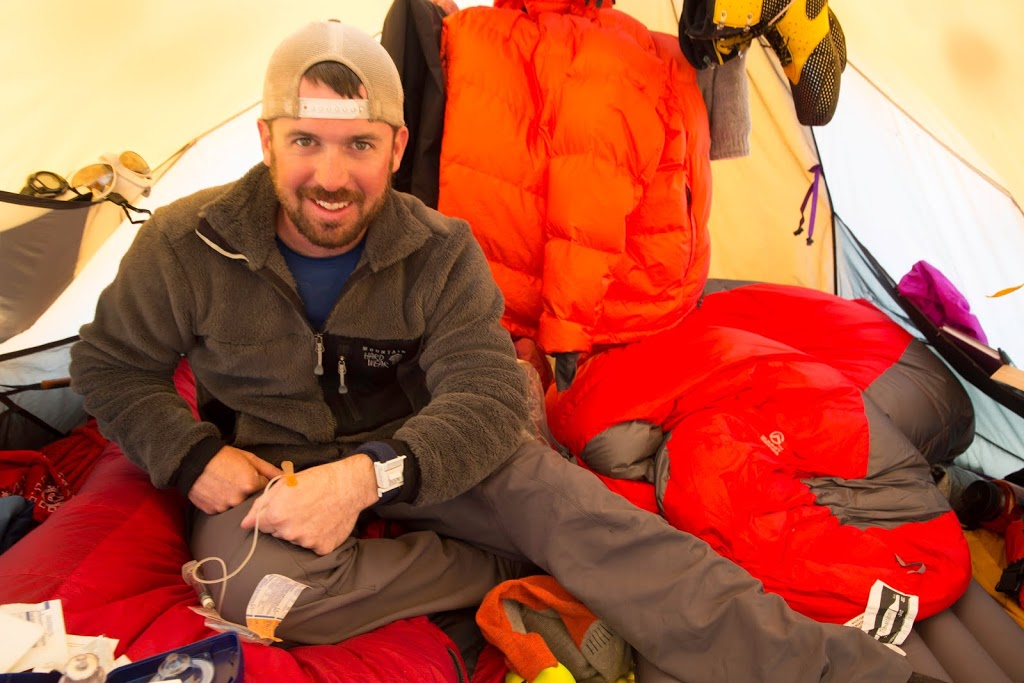 |
| Chris infusing on a summit! |
Because he has hemophilia–a “disability.” Huh. Chris has a few things to show the guys in Antarctica.
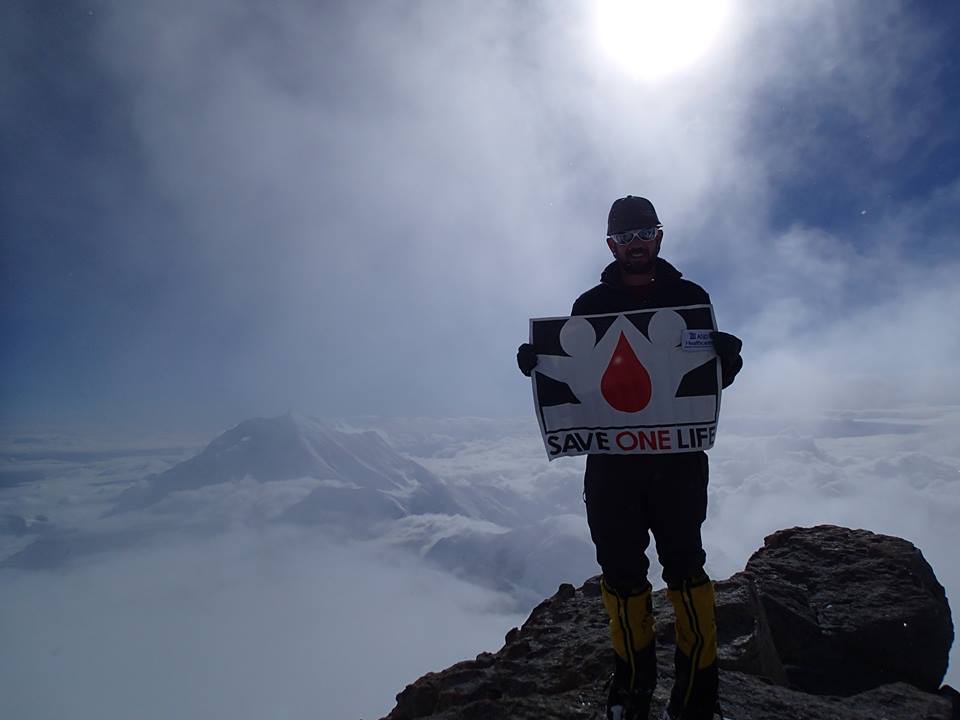 |
| Waiting to see this on Everest! |
From the bottom of our hearts and hiking boots we wish to thank Octapharma for completely funding Chris’s climb, and Believe Ltd.’s documentary. While there is no amount of money that can compensate Chris for his time and personal risks, none of this adventure and effort would be possible without Octapharma’s generous support and more importantly, its belief in Chris and Save One Life. Chairman Wolfgang Marguerre has been one of Save One Life’s biggest supporter and sponsor of children with hemophilia in developing countries. He truly believes in our mission. Thank you Mr. Marguerre and all your colleagues, including Flemming Neilsen and Carl Trenz, for your help and support!
If you would like to sponsor a chid in need, visit www.SaveOneLife.net to learn more. Together we are improving lives with hemophilia…one at a time.
What’s Your Everest?
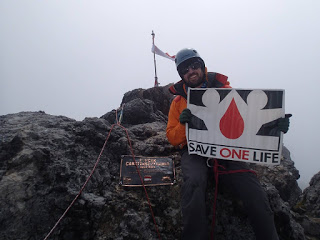 |
| Chris Bombardier on Carstenz Pyramid, one of the Seven Summits |
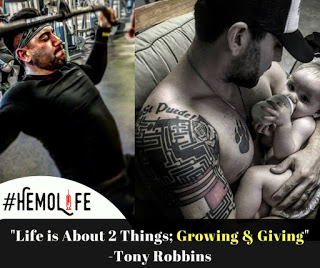 |
| One of my hemo-heroes! |
The Mountains are Calling…
What is it that makes someone crave climbing hard, cold, dangerous mountains? Is it the challenge? The view? The bragging rights?
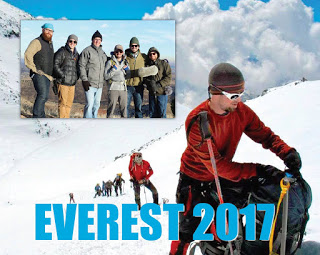 I never knew I loved mountains so much until I was well into my 40s and took up rock climbing on a whim. And that was in a gym. When I tried it outside, on New Hampshire’s Cathedral Ledge, a 500-foot sheer drop, I was hooked forever. A combination of fear, exhilaration, adrenaline, relief, and a huge sense of accomplishment flooded me. I knew very well there was a chemical aspect of this as endorphins coursed through my blood, making me feel drunkenly happy. Welcome to my new addiction.
I never knew I loved mountains so much until I was well into my 40s and took up rock climbing on a whim. And that was in a gym. When I tried it outside, on New Hampshire’s Cathedral Ledge, a 500-foot sheer drop, I was hooked forever. A combination of fear, exhilaration, adrenaline, relief, and a huge sense of accomplishment flooded me. I knew very well there was a chemical aspect of this as endorphins coursed through my blood, making me feel drunkenly happy. Welcome to my new addiction.
I also knew that the intense concentration I had just experienced for four straight hours made me completely forget the world, any worries, the future, the past. Everything was reduced to, “Find that next nub to put your toe on and hang on for your life.” It was remarkably clarifying, much like skydiving, or even playing a complex piano piece. Such intense focus actually relaxes the brain when you finish the jump or performance. It’s like meditation.
And then, there’s just something inexplicable to me about rocks. I love them. I love the sight of them, color, feel. When I see a pretty rock at my feet, I pick it up to examine it. When I drive down the highway, I scan the dynamited masses on either side and imagine trying to scale them. When I am in Utah, my rock mecca, I just gape at the surreal world of red, striated rocks that reveal the history of the earth, the mesas, the hoodoos. When I get close to rocks, I feel something; energy? I know some people swear by the healing power of certain rocks. I don’t know about that, but I do know being near them makes me feel connected to earth, to life, to the universe.
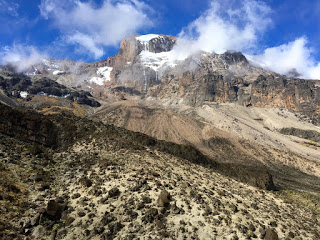 |
| My view of Kilimanjaro August 2016 |
Climbing is less about the view, and more about the journey, overcoming fears, pushing yourself to extreme limits, wringing out every ounce of strength (and oxygen) in you to see how much you can handle. It’s a psychological test set among the most beautiful places on earth.
Last summer I couldn’t wait to jump out of bed once or twice a week at 4:30 am, grab my gear, and head north to New Hampshire’s Mt. Washington for a 7-hour strenuous hike. You finish utterly wiped out, starving, grimy, sweaty, and deliriously happy. That was in preparation for Mt. Kilimanjaro last August.
Now I am training again—for Everest base came, in two and a half months.
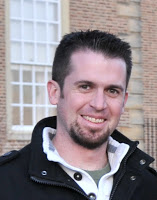 |
| Chris Bombardier |
I’ll be following in the footsteps of mountaineer Chris Bombardier, person with hemophilia B, friend, and fellow board member of Save One Life. Chris also loves mountains, and he is lucky enough to live in Denver, and grew up among rocks. Chris is attempting to complete the Seven Summits, the highest mountains on each of the seven continents. He’s completed five to date (though has “temporarily” been denied access to Mt. Vinson in Antarctica due to his hemophilia). Well, when he was denied, he thought, “I’ll show them! I’ll just climb Everest first!” So Chris will be attempting to summit Everest in early May!
If successful, Chris will become the first person with hemophilia in history to reach all Seven Summits.
He’s done five of them: Kilimanjaro (Africa), Aconcagua (South America), Denali (North America), Elbrus (Europe), and Cartstenz Pyramid (Australia). Now, just Everest in Nepal and Vinson in Antarctica remain.
You may know Chris, a rising star in the hemophilia community. I first met Chris in 2011 at NACCHO, when he was about to climb Kilimanjaro with his uncle, and I was about to climb it a few months after him as a fundraiser for Save One Life. He shared his dream and I heartily approved and told him I would help if at all possible. I’ve followed each of his summits; we helped fund one of them. When no funding seemed apparent and he would get downcast, I told him to stay positive, it will happen; nothing will stop someone with such big and noble dreams. And sure enough, the funding for Everest was daunting, for anyone but especially a young man from Denver. But luckily, I’m not the only one who believes in Chris! Octapharma, a privately owned Swiss company that manufactures blood clotting medicine, funded Chris’s fees and travel entirely!
Best of all, this historical event will be captured on film and made into a documentary by Patrick James Lynch, another rising star in hemophilia, and Believe Ltd.
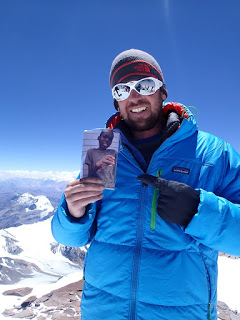 |
| Chris on Aconcagua, with picture of Brian, a suffering child with hemophilia, Chris’s motivation |
And there is a higher goal, beyond challenging ourselves and setting records in the hemophilia community. Chris wants above all to highlight the gaping disparity in treatment between the developed and developing countries. And as you know, this has been a passion of mine for the past 20 years. I’m thrilled that Chris cares as much as I do about changing the lives of 300,000 people worldwide with no access to factor. In fact, Chris is betting his life on it: a climb up Everest is difficult and dangerous. Chris is taking these risks because his reward is that the spotlight will be put on those who suffer even more.
Save One Life has been working in Nepal for years and we sponsor over 80 people there with hemophilia. We helped provide funding to rebuild homes post-earthquake, and LA Kelley Communications has helped pay for surgeries. It’s a country dear to us all.
So why do we climb? To feel rare emotions—euphoria, extreme exhaustion, deep joy, eternal gratitude. To overcome out fears; to push ourselves to the limits; to do something with lasting impact—a historical climb, a movie about hemophilia; and hopefully to change the lives of our fellow community members who need our help.
And me? I’m going to base camp at 17,600 feet after a nine day hike through stunning vistas (with yaks!), spending two days with Chris, then descending, leaving him to prepare for the climb about a month afterwards. I’ll have some stories to tell, and prayers to leave for my friend, one of the bravest guys I know.
Follow Chris’s preparation and climb on his Facebook blog Adventures of a Hemophiliac.

